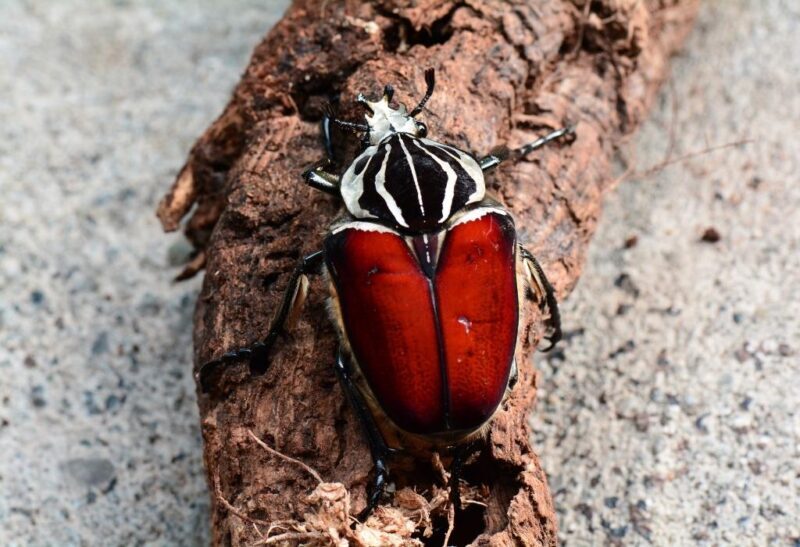Millions of years ago, animals, including insects, were known to be gigantic and scary. But as the world continues to evolve, a lot of huge insects became extinct, along with the dinosaurs. Interestingly, some insect species today are still very big. In fact, some of them are harmless and treated as pets.
What is the biggest insect in the world? According to the Guinness World Records, the record holder for the world’s longest insect is the Phryganistria chinensis. This stick insect species is 24.5 inches long. The largest beetle species in the world is the titan beetle, while the Hercules beetle is the longest.
Understanding the largest insect in the world is not straightforward, considering there are different kinds of insects. Some of them also have horns, which add to their total length.
Some insects are also not that big but are among the heaviest. Read this article carefully as you learn more about the world’s biggest insects.
Table of Contents
12 Biggest Insects in the World
The list below includes the giant burrowing cockroach, stick insects, Queen Alexandra’s Birdwing, Giant Weta, titan beetles, Goliath beetles, Atlas moths, tarantula hawks, Hercules beetles, rhinoceros beetles, sabertooth longhorn beetles, and giant water bugs. Also explained are their habitat and behaviors.
1. Giant Burrowing Cockroach
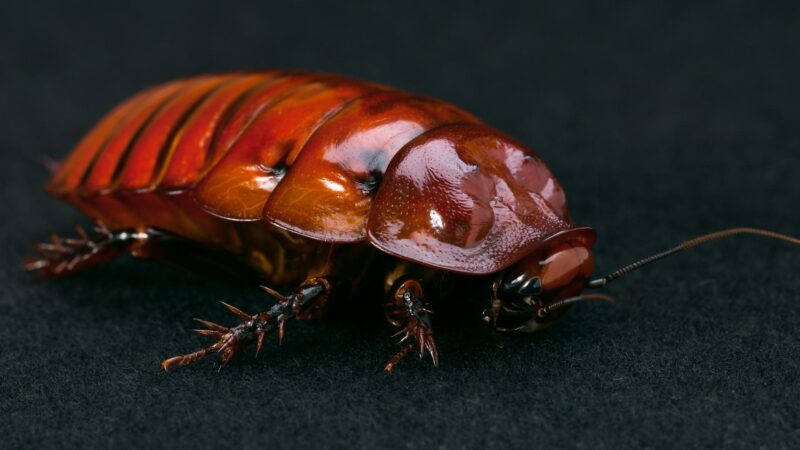
General Information
Scientifically known as Macropanesthia rhinoceros, the giant burrowing cockroach is native to Australia and is endemic, especially in Queensland and Brisbane. Also called the Queensland giant cockroach or rhinoceros cockroach, this roach species is dubbed the heaviest cockroach in the world.
Appearance
Giant burrowing cockroaches have smooth, shiny brown bodies covered with a hard shell. They also have stout, spiny legs but are wingless. Male and females look similar, except that the former has a more pronounced shovel-shaped head. This shield on top of their heads allows them to dig better and fight with rival males.
Size
The giant burrowing cockroach belongs to the Blaberidae family, which is considered the second largest roach species in the world, next to Megaloblatta longipennis. Adults can grow up to 7.5-8 cm (2.95-3.15 inches) long. Being the world’s heaviest cockroach species, they can weigh up to 30-35 grams (1-1.2 ounces).
Lifespan
The giant burrowing cockroach has an impressive average lifespan of 10 years as a pet. There is no record for those living in the wild. Unlike most roach species that lay eggs, female giant burrowing cockroaches give birth to around 30 baby roaches. These nymphs usually molt 10-12 times before becoming adults.
Habitat
The giant burrowing cockroach is native to Australia and is endemic, especially in Queensland and Brisbane. They live under the soil by digging spiral burrows that are about 1 meter deep and 6 meters long. These permanent burrows are usually found in sandy soils in tropical and subtropical parts of the country.
Diet
As herbivores, giant burrowing cockroaches eat a wide variety of fruits and vegetables, such as apples, carrots, and spinach. However, their favorite diet is dried and decaying eucalyptus leaves. These ground dwellers collect food from the surface and bring them to their underground nests to feed their young.
Threat
Since most giant burrowing cockroaches are kept as pets, they have no known predators. In the wild, these slow-moving cockroaches can be eaten by some birds. But since they consume dead leaves and similar organic matter, this loud-hissing roach species is considered a very important member of the ecosystem.
2. Stick Insects
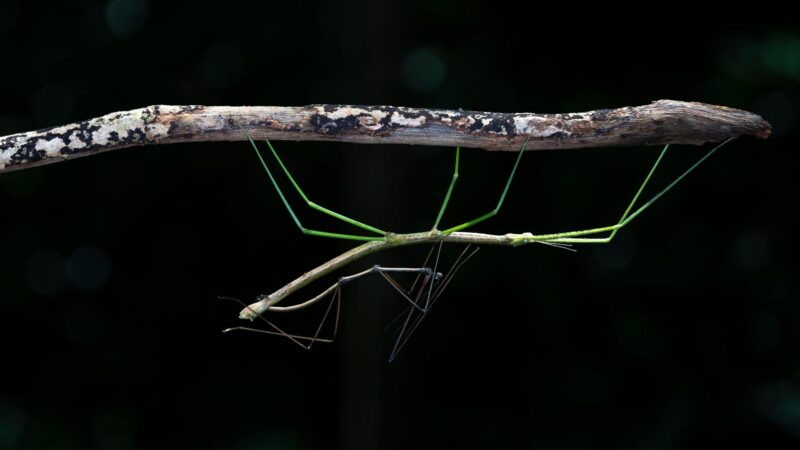
General Information
Bearing the scientific name Phasmatodea, stick insects have several common names. This includes devil’s horse, devil’s darning needle, stick bug, specter, prairie alligator, and witch’s horse. Aside from their unique physical appearance, they are also masters of disguise. Stick insects are native to North America.
Appearance
As the name suggests, the stick insect looks like a long stick and can be mistaken for a twig. Also known as walking insects, stick insects are usually green or brown and can mimic the color of their background. They have chewing mouthparts and long legs. Most species in the Northern states are wingless.
Size
Stick insects are 1-12 inches (2.5 to 30.5 cm) long, and females are usually longer than males. Phryganistria Chinensis Zhao, a stick insect species, was declared by the Guinness World Records as the world’s longest insect in 2016. It is 624 mm (24.5 inches) long, including a body length of 350 mm (13.7 inches).
Phryganistria Chinensis Zhao was discovered in Guangxi in 2014 by a Chinese entomologist named Zhao Li. Meanwhile, Chan’s megastick (Phobaeticus chani) still holds the record for the world’s longest insect body length since 2008. This stick insect is 566 mm (22.3 in) long and has a body length of 355 mm (13.9 in).
Lifespan
Depending on the species, stick insect nymphs live up to 3 years in the wild. This is probably because of their camouflage ability. Most species can also release a foul smell to scare predators away. A lot of people around the world also keep them as pets, but there is no record stating their average lifespan in captivity.
Habitat
Stick insects are widely distributed around the world except in Antarctica. They are commonly found in tropical, subtropical, and temperate regions. They live in forests, grasslands, and landscapes. Walking sticks are nocturnal, which means that they are most active at night. During the daytime, they hide under the plants.
Diet
Stick insects are herbivores but can be picky eaters. Although all of them eat leaves and shrubs, some species choose certain trees only such as apple, basswood, chestnut, hickory, ivy, oak, wild cherry, and some common garden vegetables. But then, most of them tend to avoid conifers such as pine trees.
Threat
There are no known common predators of stick insects, although they can be eaten by birds, rodents, and reptiles. But since these camouflage insects are nocturnal, they can hardly avoid bats. Instead of sight, bats hunt their prey using echolocation. They release high-pitch sound waves and depend on the echo.
3. Queen Alexandra’s Birdwing
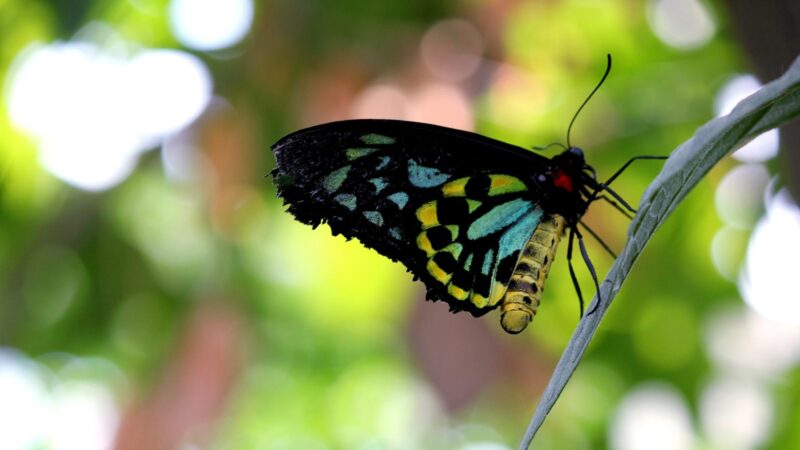
General Information
Scientifically known as Ornithoptera alexandrae, Queen Alexandra’s Birdwing is the butterfly species that was discovered in Papua New Guinea by an English naturalist named Albert S. Meek in 1906. But like other butterfly species, adults have compound eyes, six long legs, and a sucking organ called the proboscis.
Appearance
Queen Alexandra’s Birdwing is known for having enormous wings. These ever-beautiful butterflies have a black head and thorax, bright yellow abdomen, and red anteriad. Males have emerald green-blue wings, with a huge portion being black. Females have dark brown wings with some red and white spots.
Size
Queen Alexandra’s Birdwing is the world’s largest butterfly species and is also probably the most beautiful butterfly in the world. Females have an average wingspan of 187-300 mm (7.4-11.8 inches), with a body length of 80 mm (3.1 inches). Males are a bit smaller, with a wingspan of 147-200 mm (5.8-7.9 inches).
Lifespan
The life cycle of Queen Alexandra’s Birdwing is completed between 5 and 7 months, depending on the location. Eggs, which are around 3.5 mm (1/8 inches) in diameter, hatch into larvae within 11-13 days. In the wild, adult males (imago) can live up to 3 months, while females have an average lifespan of 6 months.
Habitat
Since commercial trade of Queen Alexandra’s Birdwing is illegal, they can only be found in Papua New Guinea. They live mainly in the rainforests in the country, especially in the Popondetta Plain at an elevation of around 400 meters. The green birdwing (Ornithoptera priamus) is the more common species.
Diet
The Queen Alexandra’s Birdwing eats exclusively on Aristolochia dielsiana, a relatively rare genus of vines that is also native to Papua New Guinea. High-flying females lay eggs on this toxic plant and feed on the nectar of the flower. Larvae also ingest this pipevine plant, making them toxic to their predators.
Threat
There are no known predators of Queen Alexandra’s Birdwing, but their habitat is constantly decreasing due to habitat loss. Factors included are oil palm planting and large-scale logging. In January 1951, Mount Lamington in Oro Province erupted and caused a huge population loss for this butterfly species.
Queen Alexandra’s Birdwing is now protected by CITIES (Convention on International Trade in Endangered Species of Wild Fauna and Flora). It is also listed as endangered by the IUCN (International Union for Conservation of Nature). Despite this, some butterfly collectors buy them on the black market.
4. Giant Weta
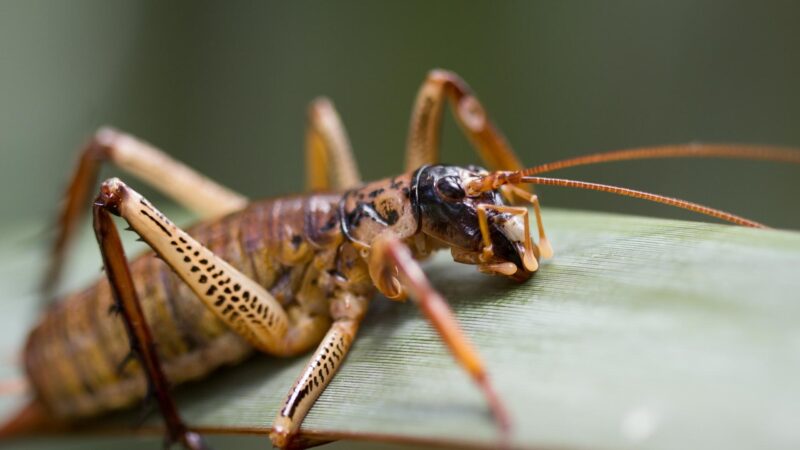
General Information
Scientifically known as Deinacrida, the giant weta is native to New Zealand. This unique insect can only be found in the country. The largest species is called wetapunga (Deinacrida heteracantha). In Greek, the genus Deinacrida means “terrible grasshopper.” In the Maori language, wetapunga means “god of ugly things.”
Appearance
The giant weta looks like a cricket that has a round head, and a broad body, with relatively short mandibles and antennae. These huge crickets are usually dark brown, but some species are yellow. It is generally wingless, but some species can develop wings when fully mature. Females have an ovipositor.
Size
The giant weta has a body length of around 4 inches (10.2 cm), and the winged ones can have an average wingspan of 7 inches (17.8 cm). Dubbed as the largest insect in the world; female adult wetapunga can weigh up to 35 grams. Also known as wetapunga, this gigantic cricket can be as big as Mongolian gerbils.
Lifespan
Giant weta nymphs undergo 11 developmental stages, and it may take them up to 2 years before reaching adulthood. Cigar-shaped eggs hatch within a year, and adults have an average lifespan of 6-9 months. Nevertheless, these gentle giant insects are said to be around for 190 million years and are older than mammals.
Habitat
The giant weta is unique to New Zealand and used to be predominant in Hauraki Gulf and Little Barrier Island (Te Hauturu-o-Toi), the country’s national reserve. As nocturnal insects, giant wetas live in caves, forests, grasslands, and shrub lands. Sometimes, they also use old burrows or dig holes in rotting logs.
Diet
The giant weta insects are generally herbivores and eat plants, especially fresh leaves of various native trees. This includes karaka (Corynocarpus laevigatus), karamu (Coprosma robusta), kohekohe ((Dysoxylum spectabile), mamangi (Coprosma arborea), and mahoe (Melicytus ramiflorus). They also eat carrots.
Threat
The main predators of giant weta are mammals such as rats, hedgehogs, and mustelids. Since these passive insects are heavy and slow, their population was greatly reduced due to predation. Deinacrida heteracantha is protected by New Zealand laws. Although not endangered, the IUCN listed them as Vulnerable.
5. Titan Beetles
General Information
Scientifically known as Titanus giganteus, titan beetles are native to South America and belong to the Cerambycidae family. These giant beetles are the only species of Neotropical longhorn beetles. At first glance, titan beetles look scary, but they are not aggressive. Little is written about their life cycle, though.
Appearance
Titan beetles look like roaches but have sharp defensive spines and superbly strong jaws that can break pencils. They are dark brown or almost black, with two compound eyes, a big black head, long antennae, and six long legs. Both sexes have a very flat abdomen, eight pairs of spiracles, and a pair of pale wings.
Size
Titan beetles are the world’s largest beetle species and one of the largest insects in the world. Adults can grow up to 16.5 cm (6.5 inches) long, and antennae can be half the body length. They have an average wingspan of 28 cm (11 inches). No titan beetle larvae have been found yet since they live deep under the soil.
Lifespan
Little is written about the life cycle of titan beetles, except that they undergo complete metamorphosis. There is also no document that states their average lifespan. Nonetheless, larvae tend to spend several years underground before they emerge as adults. Males usually die shortly after mating, while females die after laying eggs. Generally speaking, these enormous beetles don’t live long.
Habitat
Titan beetles can be found in Bolivia, Colombia, Ecuador, Peru, the Guianas, and some Northern parts of Brazil. Adults live in tropical rainforests in the Amazon, while larvae live under the soil. Although their long life remains a mystery, these larvae are considered very important in recycling dead wood into humus.
Diet
Adult titan beetles don’t eat, and their only purpose is to reproduce. On the other hand, larvae feed on rotting wood underground. A supposed photo of a titan beetle larva was published in the National Geographic magazine in 1959. But then, it was later confirmed to be another gigantic long-horned beetle species.
Threat
There are no known predators of titan beetles. Nonetheless, these gigantic invertebrates can easily defend themselves with their extremely sharp mandibles. Aside from being capable of cutting pencils into small pieces, titan beetles are also believed to be tough enough to pierce human flesh very painfully.
6. Goliath Beetles
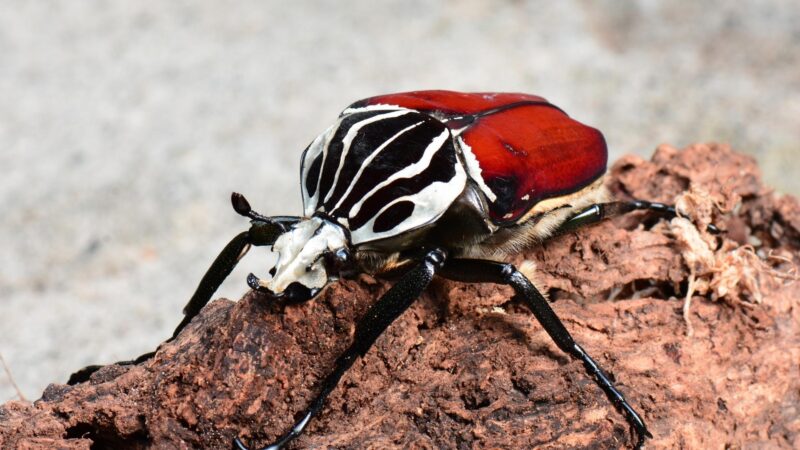
General Information
Scientifically known as Goliathus, the goliath beetle belongs to the Scarabaeidae family. The five species in the genus Goliathus are Goliathus cacicus, Goliathus regius, Goliathus albosignatus, Goliathus orientalis, and the Goliathus giganteus, also known as the African goliath beetle. All of them are native to South Africa.
Appearance
Goliath beetles are usually black, brown, or white, depending on the species. They have six legs with sharp claws, which help them in climbing trees. Adult males have Y-shaped horns they use for fighting and mating. On the contrary, females possess wedge-shaped heads and use them for digging burrows.
Size
The goliath beetle is one of the biggest and heaviest beetles in the world. Larvae are about 5 inches (12.7 cm) long and can weigh up to 100 grams (3.5 ounces). Adults are 2.1-4.2 inches (5.3-10.6 inches) long and can weigh up to 51 grams (1.8 ounces). Amazingly, they can lift about 850 times heavier than them.
Lifespan
In the wild, goliath beetles have an average lifespan of several months. But in captivity, they can live up to a year. Eggs hatch within 2 weeks, while the larval stage may take about 5 months. The pupal stage usually lasts for about three weeks. These incredible beetles are kept as pets but can be challenging for beginners.
Habitat
Goliath beetles are native to Africa, including Congo, Nigeria, and Tanzania. They usually live in warm environments such as tropical and subtropical rainforests. Eggs are laid in moist soils, while larvae stay underground until they emerge as adults. As pets, they should be kept in well-ventilated enclosures.
Diet
Goliath beetles are generally herbivores, and their main diet includes rotten fruits and plant sap. Since larvae live under the soil, they feed on plant materials and other decaying organic matter, such as dead insects and animal feces. As pets, these monstrous but docile beetles are fed with beetle jelly, fish food, and fruits.
Threat
There are no specific predators of goliath beetles. But in the wild, they can be killed and eaten by birds, frogs, lizards, and rodents. The IUCN has yet to categorize the conservation status of goliath beetles. But although they are not considered endangered, their population is greatly affected by commercial trade.
7. Atlas Moths

General Information
Scientifically known as the Attacus atlas, the atlas moth belongs to the Saturniidae family. Endemic in Asia, This gentle giant insect is most active at night and does not eat at all. Instead, it saves its energy so it can reproduce. On the other hand, their larvae eat a lot and build fats they can use once they become adults.
Appearance
Unlike butterflies and other moths, the atlas moth has non-functioning mouthparts since they have very short, vestigial proboscis. Adults have two huge compound eyes, yellowish-brown comb-like antennae, and rounded wings that are particularly wide. The patterns of their wings look like a paper map.
Size
Considered one of the biggest moth species in the world, the atlas moth can be 39-40 mm (1.5 inches) long for females and 30-36 mm (1.1-1.4 inches) for males. Females have a very impressive average wingspan of 240-250 mm (9.4-9.8 inches), while males have a wingspan of 210-230 mm (8.3-9.0 inches).
Lifespan
Adult atlas moths have a relatively short lifespan and may live for 1-2 weeks only, depending on their activities. Nevertheless, larvae live between 68 and 100 days in laboratories and captivity. They undergo 5 to 6 larval stages, wherein the last stage may last for 15 days. Females usually live longer than males, though.
Habitat
Atlas moths are widely distributed across Southeast Asia. This includes parts of Bangladesh, Brunei, China, India, Indonesia, Taiwan, Papua New Guinea, and the Philippines. They usually live in tropical and subtropical rainforests. Note that most of the countries mentioned only have two seasons – wet and dry.
Diet
As mentioned earlier, the mouthparts of adult atlas moths have no function at all. Therefore, they don’t eat, and they usually die after mating. Females lay eggs on their host plants, which include cardamom, citrus, cinnamon, cherry, guava, mango, privet, and tea. Larvae eat their leaves only, not the stems and flowers.
Threat
The most common natural predators of atlas moths are birds and lizards. But when threatened, adult moths protect themselves by opening their wings and shaking them. During this position, the edges of their wings look like the head of a snake. From another angle, they also seem to resemble pupils of watching eyes.
8. Tarantula Hawks
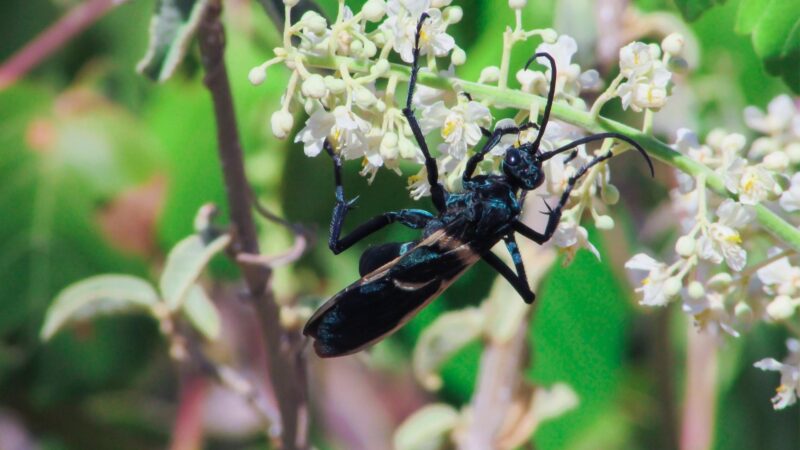
General Information
Contrary to what some people think, tarantula hawks are not birds of prey. Instead, they are wasps that hunt for food as hawks do. Scientifically known as Pepsini, tarantula hawks are also called spider wasps since they hunt for spiders, particularly tarantulas. Adult females don’t eat tarantulas but rather feed them to their young.
Appearance
Tarantula hawks have a bright metallic blue-black body and bright orange wings that can distract potential predators. Females have curly antennae, while males have straight antennae. Both sexes have black antennae and six long legs with hook-like claws on the ends. Their body and legs are covered with sharp spines.
Size
Dubbed as one of the largest wasps in the world, tarantula hawks are about 5 cm (2 inches) in body length. They have a wingspan of about 4 inches, but they fly very low. Females have a 7 mm (1/4 inch) stinger and will sting when provoked. However, their sting is extremely painful. Males don’t have stingers, though.
Lifespan
Tarantula hawk eggs hatch in 3-4 days, while the larval stage may take 3 weeks. Once the adult emerges from the cocoon, females can live for 4-5 months. Adult males have only an average lifespan of less than a month.
Habitat
Tarantula hawks are widely distributed among all continents except Antarctica. In North America, the most common species is the Pepsis Thisbe, which is very common in the Grand Canyon. These solitary wasps also live in deserts. Since 1989, the tarantula hawk has become the official state insect of New Mexico.
Diet
As the name implies, tarantula hawks are major predators of tarantulas. Adults feed on the nectar of flowers, but they hunt tarantulas to feed their young. Females sting tarantulas and paralyze them. Shortly, they will drag the huge spiders to their burrows and lay eggs on them. Larvae will then eat the live tarantula.
Threat
Since tarantula hawks have a very powerful stinger, they only have a few predators. This includes bullfrogs, kingbirds, and roadrunners. Tarantulas may try to fight back against these wasps, but they only end as unlucky victims of venom.
10. Hercules Beetles
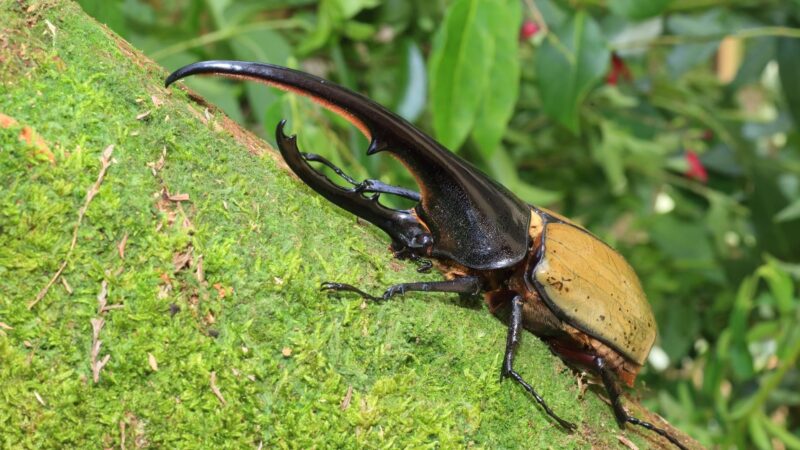
General Information
Scientifically known as Dynastes Hercules, the Hercules beetle is a species of rhinoceros beetles. The terms “rhinoceros beetle” and “Hercules beetle” are often used interchangeably. These two beetle species are somehow similar but are two different insects. Hercules beetles are named such because of their super strength.
Appearance
Adult Hercules beetles have large eyes, a robust body, and clubbed antennae. Males have cephalic horns that look like pincers or huge claws. They use these horns for fighting other males to show supremacy. Females don’t have horns, though. Males are usually black, brown, or green, while females are mostly dark.
Size
Adult male Hercules beetles are 78-180 mm (3-7 inches) long, including their horns. This makes them the longest beetle species in the world. Their horns are about one-third of their body length. Females are only about 61.8 mm (2.4 inches) long. Larvae are around 11 cm (4.3 inches) and weigh approx. 140 grams.
Lifespan
Hercules beetle eggs typically hatch within a month, while larvae undergo three instar stages that last for 12-18 months. The pupal stage usually lasts for 2-3 months, while adults can live for 8-12 months in the wild. In captivity, adults live for 2-3 months only. Hercules beetles have an average lifespan of 34 months.
Habitat
Hercules beetles are native to Central and South America, including southern parts of Mexico, Bolivia, and Trinidad, as well as the Lesser Antilles. They live in lowland rainforests and pockets of montane, and females lay eggs on dead wood or the ground. Some species can be found in Brazil, Colombia, and Ecuador.
Diet
Hercules beetle larvae eat rotting wood, while adults feed on fruits, including apples, bananas, grapes, peaches, and mangos. They eat both fresh and rotting fruits that fall from the trees. Since these beetle species are nocturnal, they usually forage at night. Being called Hercules, adults can lift 850 times their body weight.
Threat
Due to their massive appearance and tremendous strength, Hercules beetles have no recorded predators. Since they don’t bite and are not destructive pests, these gigantic beetles can make good pets, even for beginners. But in the wild, adults and exposed larvae can easily be eaten by birds, bats, and rodents.
10. Rhinoceros Beetles
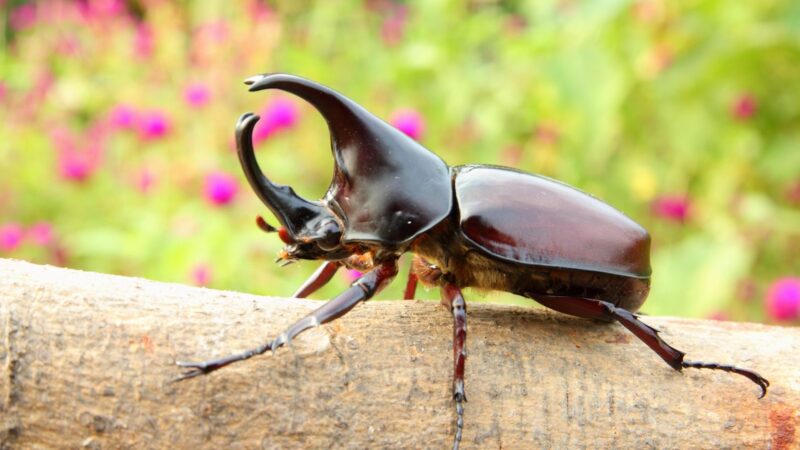
General Information
Scientifically known as Dynastinae, the rhinoceros beetle belongs to the Scarabaeidae family and is known for having impressive horns. Also called elephant beetles or horn beetles, this family of scarab beetles has more than 1,500 species, and each species has a unique horn-like structure on its head.
Appearance
As the name suggests, the horns of rhinoceros beetles resemble the horns of a rhino. On the other hand, the horns of Hercules beetles look like a can opener when viewed from the side. Aside from that, rhino beetles have shorter horns than Hercules beetles. Other rhino beetle species have different horn shapes.
Size
Generally speaking, rhinoceros beetles are smaller than Hercules beetles and have an average length of 15 cm (6 inches). Males are usually twice the size of females. The elephant beetle (Megasoma elephas) is a rhino beetle species that can reach up to 12.7 cm (5 inches) and is one of the world’s largest beetles.
Lifespan
Just like Hercules beetles, rhinoceros beetles complete their life cycle within 1 to 2 years, depending on the species. Their larvae also have the longest lifespan. They undergo 2 to 3 larval stages, which can last for one year and a half. Adults can live for 3 to 6 months as pets and a year in the wild.
Habitat
Rhinoceros beetles are widely distributed across the globe, except in Antarctica. In some parts of Asia, they are usually kept as pets. In the United States, these enormous beetles are usually found in the Southern states such as Arizona and Nebraska. Rhino beetles live in fallen logs, leaf litter, and various plants.
Diet
Rhinoceros beetles are generally herbivorous, which means that they eat fruits and vegetables. Larvae eat almost any kind of plant matter, including leaves and rotting wood on the ground. Adults also feed on tree sap and fruits but not so much on decaying wood. They eat less than larvae do, and some don’t eat at all.
Threat
Rhinoceros beetles have some predators in the wild. This includes raccoon dogs, jungle crows, and rats. Being nocturnal creatures, they are also killed by snakes and bats. Since their horns are short, they try to escape instead of fighting back. Meanwhile, some males are killed by other males during a fight over a female.
11. Sabertooth Longhorn Beetles
General Information
Scientifically known as Macrodontia cervicornis, the sabertooth longhorn beetle is known for staying as larvae for a decade. Their adults are short-lived and are quite rare. But because of their impressive looks, this beetle species is a favorite of insect collectors who are willing to pay thousands of dollars for a single specimen.
Appearance
Sabertooth longhorn beetles are known for their huge mandibles for males, hence the name. In dental medicine, macrodontia means that some or all the teeth are larger than usual. A perfect example of a mammal with this rare tooth condition is the now-extinct saber tooth tiger.
Size
According to the American Museum of Natural History, sabertooth longhorn beetles can reach up to 17.8 cm (7 inches) long, including their serrated jaws. Despite being smaller than Hercules beetles, they are still among the longest beetle species. Females are shorter than males since they have no mandibles.
Lifespan
Unfortunately, very little is written about the life cycle of sabertooth longhorn beetles. Nevertheless, the larval stage of these gigantic beetles is said to last for 10 years, while adults have an average lifespan of only a few months.
Habitat
Sabertooth longhorn beetles are native to South America and can be found especially in Brazil, Bolivia, Colombia, and Ecuador. They live in humid rainforests in the Amazon, and females lay eggs on softwood trees.
Diet
Sabertooth longhorn beetle larvae feed on dead trees and decaying wood. Adults don’t eat and usually die after mating.
Threat
There are no documents stating the natural predators of sabertooth longhorn beetles. However, their population has greatly declined due to habitat loss. This is after huge parts of the Amazon were converted to ranches and soybean fields. As of 1996, the IUCN has listed sabertooth longhorn beetles as Vulnerable.
12. Giant Water Bugs
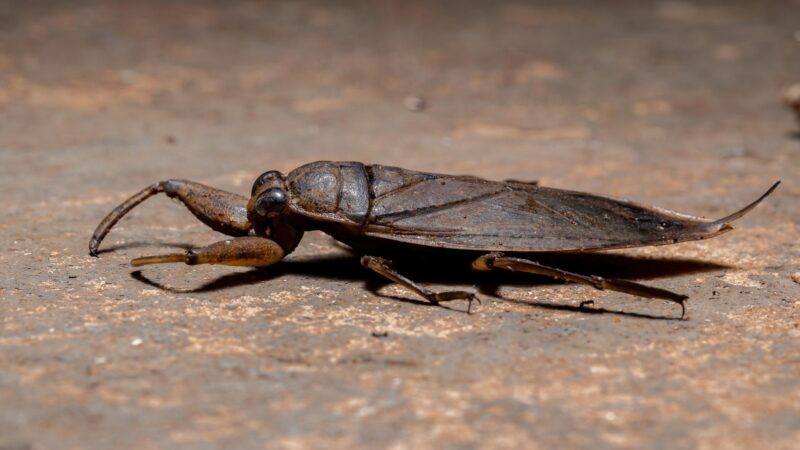
General Information
Scientifically known as Lethocerus americanus, the giant water bug (GWB) is an aquatic insect with very interesting characteristics. Also referred to as electric light bugs, they can pretend to be dead, and most males carry eggs on their backs. One species holds the record as the largest aquatic insect in the world.
Appearance
Giant water bugs look like a cross of a cockroach and a praying mantis. Some people may mistake them for a baby roach. They possess short, retractable tubes that serve as a snorkel, which helps them breathe while under the water. They have a short beak, brown, elongated body with pointed ends, and six legs.
Giant water bugs have two raptorial front legs designed to grab prey. Their middle and hind pairs of flat legs look like paddles, which helps them swim actively. Nymphs look similar to adults, except they are smaller. Nevertheless, they are equally fearless predators, and their claws can kill prey larger than them.
Size
Giant water bugs are about 2-3 inches (5-7.6 inches) long, while some species can reach up to 4 inches (10 cm). According to the Guinness World Records, a giant water bug species named Lethocerus Maximus is the world’s largest aquatic insect. This gigantic bug has a whooping length of 4.53 inches (11.5 cm).
Lifespan
Depending on the species, the life cycle (from eggs to adults) of giant water bugs is usually completed in 1-2 months. Eggs hatch into nymphs, which undergo 5 developmental stages that last for about two months. These nymphs will grow wings once they become adults, which have an average lifespan of 1 year.
Habitat
Since they are aquatic insects, they usually live in ponds, lakes, ponds, streams, and other similar bodies of water. They are commonly found in stagnant and slow-moving freshwater, such as swimming pools. Giant water bugs also live in damp, moist areas with lots of vegetation, where they can find food.
Diet
As expected, giant water bugs prey on small aquatic animals such as crickets, ducklings, fish, frogs, snails, snakes, and turtles. As great flyers and ambush predators, adults snatch their unsuspecting prey and paralyze them by injecting poisonous enzymes. Amazingly, they can eat animals 50 times bigger than them.
Threat
Despite being fearless attackers, giant water bugs also have some natural larger predators, such as birds and fishes. To protect themselves, they emit unpleasant smelling fluid from their anus from a few feet away. These true bugs can also play dead by not moving or freezing their bodies for several minutes in the water.
Sad to say, some of these biggest insects are now declining due to habitat loss and illegal selling. As nature continues to surprise us, let us cherish what we still have today. Let us take care of these insects only for our eyes but also for our environment. After all, these insects are also beneficial to our ecosystem.
List of Sources
Walking Stick. Iowa State University Extension and Outreach.
Tajchman, P. (2021). Attacus atlas. Animal Diversity Web.
Safford, M. M. (2015). Tarantula Hawk. National Park Service – U.S. Department of the Interior.
Kulikowski, A. (2014). Dynastes hercules. Animal Diversity Web.
Gray, B. (2006). Giant Water Bug. Texas A&M University.
